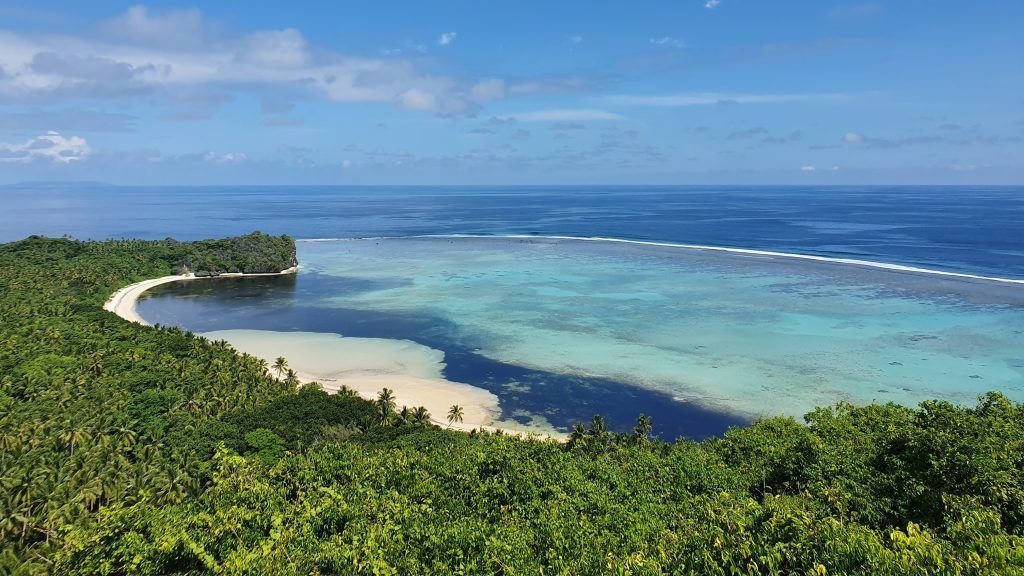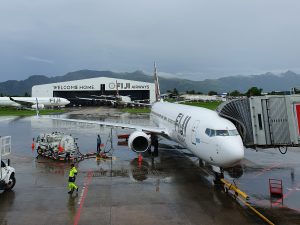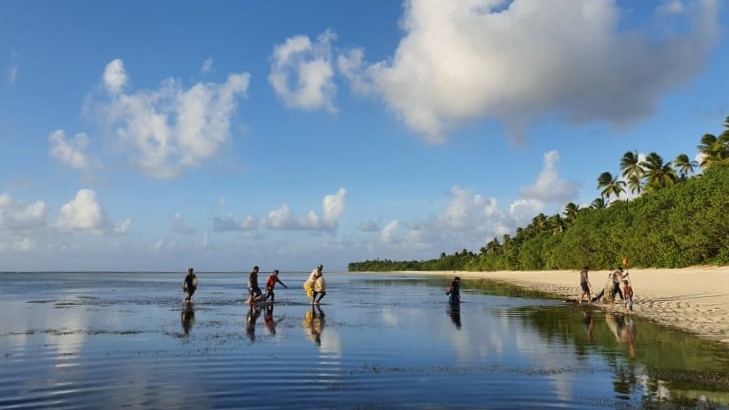In this post, Håkon Larsen discusses the crucial role of coastal resources in Fiji during the COVID-19 pandemic, by drawing on some of the materials from his master’s thesis The Organic Island that explores the creative and resilient dimensions of subsistence economics.

Last year, prior to the pandemic-related travel restrictions, I was fortunate enough to carry out a few months of fieldwork in Fiji for my master’s degree in social anthropology. A large part of this research was conducted on the island of Cicia, located in the Lau Archipelago of eastern Fiji. A central part of my research considered the importance of seafood for coastal communities. Given that the importation of supplies to the island is limited, subsistence resources are the most crucial to people’s everyday diets on Cicia. Yet, as the people there will tell you, these resources are not simply valued for their nutritional features. Dietary categories like seafood can also be viewed as underpinning social relationships and cultural practices in various ways; providing an ecological basis of creative resilience (see Larsen 2021). As the pandemic began to make its impact in Fiji, I came to realize the significance of the insight people shared, regarding the deep sociocultural importance of the ocean and its resources.

The coastline of Cicia nearby Mabula village. Photo by author.
Intercoupled with the severe health-associated risks of COVID-19, drastic measures to limit the spread of the virus havocked national economies world-wide. In relation to Fiji’s economy, international travel restrictions came at a clear cost; given the heavy reliance on cash flow derived from its tourist industry, tens of thousands of people soon found themselves out of work, with limited cash to support their livelihoods. As prime minister Frank Bainimarama said in July 2020, the pandemic came to be known as the “job-killer of the century”. Not only did workers employed in the tourism industry (Fiji’s largest formal employment sector) lose their income source. Indirectly, the economic downturn also produced economic anxieties for local fishers, farmworkers, taxi drivers, Pacific artists and other craftsmen who have long supported tourist resorts with their labor. Suddenly, one could observe how adversely the economy of Fiji was structurally dependent on foreign capitalists and visitors to stimulate the country’s labor market.

The tarmac of Nadi International Airport, with multiple aircrafts in the background parked outside one of the aircraft hangars, as 95% of Fiji Airways’ flight routes was cancelled in mid-March 2020. Photo by author.
As for my own research plans, the uncertainties caused by the pandemic forced me to return to Norway three months ahead of schedule, where I continued to do my fieldwork remotely by following various activities in Fiji through social media. Through the process of returning from Fiji to Norway, I recall far too well the devastating sense of insecurity that permeated discourses in the capital of Suva after Fiji’s government confirmed its first recorded case of COVID-19 in March 2020. While there still was much uncertainty surrounding the expected severity and duration of the pandemic, one could hear people raise not only the obvious health concerns, but moreover the feared economic implications of a lockdown for the country. Recorded coronavirus cases remained low until April 2021 when Fiji first began experiencing larger community outbreaks. Nonetheless, as most anticipated, a UN assessment report confirmed that the national economy and employment sector was severely affected following the border closures in 2020.

Amid these severe economic anxieties, however, one could also observe a somewhat different image; how grassroots in Fiji began developing creative systems to handle and mitigate the uncertainties people experienced. In late April 2020, a community established itself on Facebook under the name Barter for Better Fiji (BBF) to facilitate non-monetary forms of exchange of goods and services. The group’s aim, as recurrently stressed by group members, was to form an alternative to the monetary system that could restructure economic relations around ‘values of kindness’, by prohibiting the direct use of cash in trade activities. During its initial weeks, the barter group gained an exponential growth of members and consists today of nearly 200,000 people. This enormous figure amounts close to the majority of Fiji’s adults and more than one fifth of the country’s total population; speaking volume of the group’s popularity which triggered early on international media attention.
People engage in the barter system by simply posting what they have to offer in terms of various items or services, in addition to stating what they look for in exchange. There has been a frequent use of subsistence produce, like root crops and seafood, to acquire things that otherwise would be inaccessible for people who lacked a source of income. Items and services that typically require the expenditure of cash can now be obtained by trading taro, fish, crabs, and other food items, which facilitate direct exchanges between people from different parts of society. During my observations, I would note, for instance, how wealthy people would trade expensive objects in exchange for freshly caught seafood. A few bundles of fish and a couple of squids could be easily swapped for a flat screen TV, and mud crabs collected in a rural village were traded for groceries and school utensils provided by urban dwellers. Other products and craft items are also regularly traded, but it is notably subsistence crops and fresh seafood which have been some of the most reliable items to use in exchanges on BBF, as reflected by how quick those posts are usually turned over in trades.
Little evidence suggest that values of exchange have been carefully calculated by participants in BBF. In fact, when market price overviews were shared in the group, I observed people slamming these proposals, with the argument that they opposed the group’s purpose to form economic relationships around the ‘values of kindness’. Instead, posts that described how bartering partners surprised one another by bringing additional gifts to supplement the prearranged trade deals were much more celebrated by group participants. In this manner, the group tried to distinguish itself from the capitalist market of self-interests by encouraging acts of kindness.
Among group members themselves, there have also been extensive discussions regarding the significance and implications of the exchange activities, which many have noted that they resemble what is customarily known in Fiji as veisa; a form of exchange practice based on principles of reciprocity and a form of competition by displaying social strength through generosity. Scholars have suggested that initiatives like BBF are examples of how discourses of economic development are being actively and creatively re-storied throughout Oceania (see Kabutaulaka 2020). As much of the participation in the capitalist economy withered during the pandemic lockdown, customary practices centered around the use of subsistence resources have been revitalized, which has led to an increased attention and appreciation toward the local importance of land and ocean in Fiji.

While the pandemic certainly devastated the national economy of Fiji, it concurrently spurred an instant intensification of repertories associated with the subsistence economy of rural villages in particular. On Cicia, while daily diets already consisted primarily of subsistence goods, the pandemic increased the use of local sea and land resources as domestic lockdowns restricted the transportation of imported goods to the island. Although store shelves in village shops were quickly emptied, interlocutors of mine would comment – via text messages – how appreciative they were of the fact that their land (vanua) and ocean provided more than enough to sustain their daily needs. To them and the people of BBF, the pandemic did not simply illuminate a state of vulnerability in Fiji; it also showed dimensions of social resilience, founded in subsistence economic practices and everyday forms of cultural innovations, during severe oscillations in the capitalist economy.

A group of fishers pulls ashore a catch collected by the use of fishing nets on Cicia. Photo by author.

 Håkon Larsen is a research assistant who holds an MA in social anthropology from the University of Bergen, with fieldwork experience from Fiji. His interest of research has focused on the socioenvironmental aspects of spearfishing, development, and the creativity and resilience of subsistence economics in the island group of Lau. He currently works with website and blog management, communication, and administration on the Island Lives, Ocean States project.
Håkon Larsen is a research assistant who holds an MA in social anthropology from the University of Bergen, with fieldwork experience from Fiji. His interest of research has focused on the socioenvironmental aspects of spearfishing, development, and the creativity and resilience of subsistence economics in the island group of Lau. He currently works with website and blog management, communication, and administration on the Island Lives, Ocean States project.
References:
Kabutaulaka, T. (2020). COVID-19 and Re-Storying Economic Development in Oceania. Oceania, 90: 47-52. https://doi.org/10.1002/ocea.5265
Larsen, H. (2021). The Organic Island: An ethnographic study of subsistence economics and creative resilience in the Lau Islands of Fiji. Master’s thesis. Bergen: University of Bergen. https://hdl.handle.net/11250/2772349